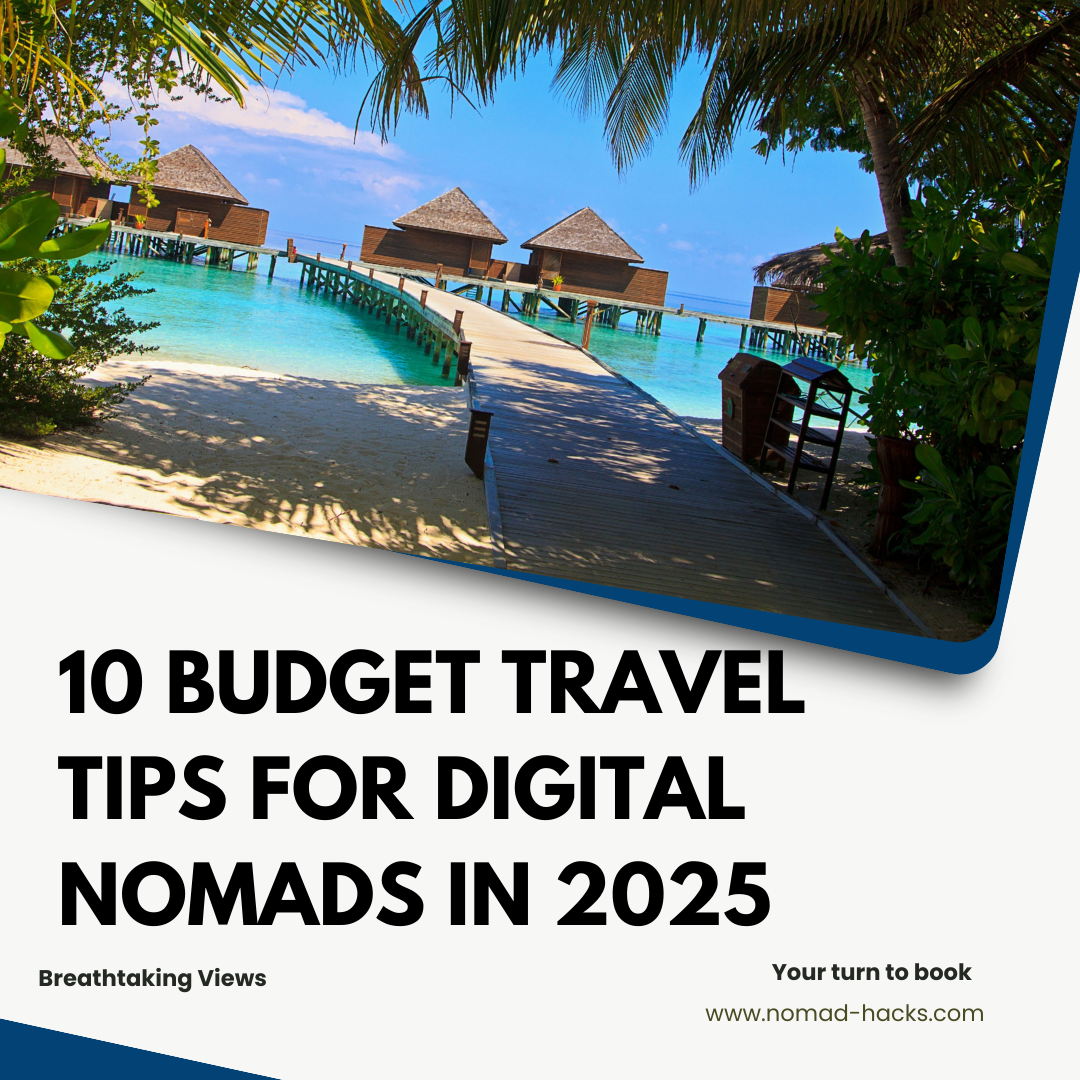Traveling as a digital nomad offers the ultimate freedom exploring new cultures while earning a living remotely.
However, without careful budgeting, costs can spiral quickly. The good news? With smart strategies, you can travel longer, work comfortably, and experience more for less.
In this in-depth guide, we’ll break down 10 essential budget travel tips for digital nomads in 2025, including real-world examples, tools, and visuals to help you maximize savings.
Plus, we’ll show you how Expedia can help you book affordable flights and accommodations effortlessly.
How To Become A Digital Nomad And Live For Free
1. Travel During Off-Peak Seasons (Save 30-50%)

Peak season means inflated prices, crowded destinations, and limited availability. By traveling during shoulder or off-peak seasons, you’ll enjoy lower costs and a more relaxed experience.
Best Off-Peak Travel Times for Digital Nomads:
- Europe (Avoid June-August): Travel between September-October for pleasant weather, cheaper stays, and fewer tourists.
- Southeast Asia (Avoid December-January): Visit from April-June (before monsoon season) for lower hotel rates in Bali and Thailand.
- Latin America (Avoid Christmas & Easter): Explore during May-June and September-October for great weather at lower prices.
Pro Tip: Use Expedia’s “Flexible Dates” tool to compare flight and hotel prices across different months. Some destinations (like Portugal) even offer long-term stay discounts in winter.
2. Book Affordable Flights with Expedia (Save $100s)
Airfare is often the biggest expense, but strategic booking can lead to huge savings.
How to Find Cheap Flights in 2025:
- Set Up Price Alerts: Expedia and Google Flights notify you when prices drop.
- Book on Tuesdays/Wednesdays: Airlines often release discounts mid-week.
- Use Nearby Airports: Flying into a smaller city (e.g., Berlin Schönefeld instead of Frankfurt) can be cheaper.
- Try “Hidden City” Ticketing (Carefully): Booking a flight with a layover in your desired destination can sometimes be cheaper (but check baggage policies).
👉 Example: A round-trip flight from NYC to Lisbon might cost $1,200 in July but only $650 in September—nearly 50% off!
3. Stay in Budget-Friendly Accommodations (From $10/Night)

Hotels are convenient but often overpriced for long-term stays. Try these alternatives:
How to Find Cheap Flights in 2025
📊 Set Up Price Alerts – Use Google Flights, Skyscanner, Expedia, and Hopper to get notified when fares drop.
🔹 Best for: Tracking price fluctuations and booking at the lowest rate
🔹 Example: Google Flights can alert you when a ticket drops $100+
📅 Book on Tuesdays/Wednesdays – Airlines release mid-week discounts, and flights tend to be cheaper compared to weekends.
🔹 Best for: Finding the lowest fares on domestic and international flights
🔹 Example: A flight booked on Tuesday can be 10-20% cheaper than one booked on Friday
🌍 Fly from Nearby Airports – Check alternative airports instead of major hubs.
🔹 Best for: Saving money on departure and arrival fees
🔹 Example:
✔️ Flying into Berlin Schönefeld instead of Frankfurt can save $100+
✔️ Landing in Oakland instead of San Francisco can be 20% cheaper
💻 Browse in Incognito Mode – Flight prices can increase after repeated searches due to tracking cookies.
🔹 Best for: Avoiding dynamic price hikes
🔹 Example: Searching the same route multiple times on the same browser may increase prices
✈️ Try “Hidden City” Ticketing (Carefully) – Websites like Skiplagged find flights where your destination is a layover, making it cheaper than a direct flight.
🔹 Best for: One-way trips with carry-on luggage
🔹 Example: A NYC → Paris flight may be cheaper with a layover in Madrid than booking a direct NYC → Madrid ticket
🛄 Avoid Extra Fees by Packing Light – Airlines make money on baggage fees, so travel with a carry-on only whenever possible.
🔹 Best for: Budget travelers who want to avoid surprise charges
🔹 Example: Low-cost airlines charge $30-$50 for checked bags
📍 Use Flight Search Engines That Include Budget Airlines – Some search engines exclude low-cost carriers, so use multiple tools.
🔹 Best for: Finding the cheapest no-frills tickets
🔹 Best tools:
✔️ Kiwi.com – Finds unique routes with budget airlines
✔️ Skyscanner – Shows the cheapest months to fly
🕒 Be Flexible with Dates & Destinations – Prices drop significantly during shoulder seasons (spring & fall).
🔹 Best for: Long-term travelers with flexible schedules
🔹 Example: A flight from NYC to Lisbon costs $1,200 in July but only $650 in September
💳 Use Travel Rewards & Airline Miles – Many travel credit cards offer sign-up bonuses and 2-5x points on flight purchases.
🔹 Best for: Free or discounted flights using miles
🔹 Example:
✔️ Chase Sapphire Preferred – 60,000 bonus points = $750 in travel
✔️ American Express Platinum – Transfer points to airlines for upgrades
🔄 Book One-Way Tickets Separately – Sometimes, booking two one-way tickets instead of a round trip is cheaper.
🔹 Best for: Customizing multi-city trips
🔹 Example: Flying NYC → Madrid on one airline and Lisbon → NYC on another can save $150+
🚀 Pro Tip: Check Google Flights’ “Explore” feature to see the cheapest destinations from your location!
4. Use Public Transportation (Save $100s Monthly)

Rideshares and taxis drain budgets fast. Instead:
Cheap Transport Options Worldwide:
🚌 Local Buses & Trains – Most cities in Asia, Latin America, and Eastern Europe have affordable public transport that costs between $1-$3 per ride, making them the cheapest way to get around.
🔹 Best for: Budget travelers and long-distance city commutes
🔹 Example:
✔️ Bangkok’s BTS Skytrain – $1 per ride vs. $8 for a 30-minute Uber
✔️ Mexico City Metro – Just $0.30 per ride, one of the cheapest metros in the world
✔️ Istanbul Tram & Ferry – Around $0.50 per ride, connecting key attractions
🚲 Bike Rentals & Bike-Sharing Apps – Many cities offer public bike rentals for $3-$10/day, perfect for short commutes and sightseeing. Some cities even provide free first-hour rides.
🔹 Best for: Avoiding traffic and staying active
🔹 Example:
✔️ Amsterdam (OV-Fiets) – $5/day for bike rentals
✔️ Barcelona (Bicing) – $0.75 per ride, great for tourists
✔️ Taipei (YouBike) – Free for the first 30 minutes
🚶 Walking – 100% free and the best way to explore! Many historic districts and tourist areas are pedestrian-friendly, saving you money while helping you discover hidden gems.
🔹 Best for: Short distances, sightseeing, and getting local experiences
🔹 Example: Walking 1-2 km in Paris or Rome lets you enjoy street performances, markets, and historic sites for free.
🛵 Scooter & Moped Rentals – In cities like Bali, Ho Chi Minh City, and Lisbon, renting a scooter is cheaper than taxis and gives you more flexibility.
🔹 Best for: Adventurous travelers comfortable with two-wheelers
🔹 Example:
✔️ Bali – Scooter rental for $5/day vs. Grab ride for $5 each way
✔️ Ho Chi Minh City – $40/month for a rental scooter
🚗 Carpooling & Ride-Sharing Apps (Cheaper Alternatives to Uber) – Instead of booking private rides, carpooling services cut costs. Some apps match passengers heading in the same direction for cheaper fares.
🔹 Best for: Medium-length trips where public transport is inconvenient
🔹 Example:
✔️ BlaBlaCar (Europe & Latin America) – Shared long-distance rides at 50% less than trains
✔️ Lyft Line & Uber Pool (USA) – Save up to 40% compared to solo rides
🚠 Alternative Transport (Ferries, Cable Cars, Tuk-Tuks, Songthaews) – In some countries, local alternatives offer unique experiences and cost less than taxis.
🔹 Best for: Scenic routes and avoiding city traffic
🔹 Example:
✔️ Venice Vaporetto (Italy) – $8 for a ferry ride vs. $50+ for a gondola
✔️ Medellín Cable Cars (Colombia) – $1 per ride vs. $8 Uber
📱 Pro Tip: Use Google Maps, Rome2Rio, and Citymapper to compare cheap transport options in your city!
Tips For a Financial Plan to Sustain Your Nomadic Lifestyle
5. Cook Your Own Meals (Save $300+/Month)
Eating out daily adds up especially in touristy areas.
How to Eat Well on a Budget as a Digital Nomad
🛒 Shop at Local Markets – Buying fresh produce, meat, and staples at local farmers’ markets or street vendors can be 50-70% cheaper than supermarkets. Plus, it’s a great way to try regional ingredients!
🔹 Best for: Fresh fruits, vegetables, spices, and street food snacks
🔹 Example:
✔️ Mexico City’s La Merced Market – Fresh avocados for 50% less than supermarkets
✔️ Chiang Mai’s Warorot Market – Affordable Thai spices, rice, and produce
🏡 Stay in Places with Kitchens – Choosing an Airbnb, hostel, or coliving space with a kitchen lets you cook instead of eating out daily.
🔹 Best for: Saving money on breakfast, lunch, and snacks
🔹 Example:
✔️ Hostelworld – Many hostels have shared kitchens
✔️ Selina Co-Living – Offers community kitchens for remote workers
🍲 Meal Prep & Cook in Bulk – Buying ingredients in larger quantities and prepping meals in advance can cut food costs by up to 50%.
🔹 Best for: Saving time and reducing food waste
🔹 Example:
✔️ Cook in bulk – Rice, pasta, lentils, and veggies last for multiple meals
✔️ Make overnight oats – Cheap, healthy, and easy breakfast option
🌯 Eat Where Locals Eat – Tourist areas have inflated prices, so look for family-owned restaurants, street food stalls, and local canteens.
🔹 Best for: Authentic food at local prices
🔹 Example:
✔️ Bali’s Warungs – $1-$3 meals vs. $10+ at tourist restaurants
✔️ Bangkok’s Street Stalls – Pad Thai for $1.50 vs. $8 in malls
💡 Use Budget Food Apps – Apps can help you find discounts, meal deals, and food-sharing opportunities.
🔹 Best for: Finding cheap eats and reducing food waste
🔹 Example:
✔️ Too Good To Go (Europe & USA) – Get leftover food from restaurants at 80% off
✔️ HappyCow (Worldwide) – Find affordable vegan/vegetarian meals
🥪 Pack Snacks for Travel Days – Airport food, train station meals, and convenience store snacks are overpriced. Bring homemade sandwiches, fruits, or nuts to avoid last-minute expensive purchases.
🔹 Best for: Avoiding overpriced airport food
🔹 Example:
✔️ A homemade sandwich costs $2 vs. $8 at an airport café
🍜 Try Local “All-You-Can-Eat” Buffets – Many countries have affordable buffet-style restaurants with unlimited servings of local dishes.
🔹 Best for: Eating a filling meal at a set price
🔹 Example:
✔️ Brazil’s Kilo Restaurants – Pay per gram instead of per plate
✔️ Vietnam’s Vegan Buffets – All-you-can-eat for $2-$5
🚰 Drink Tap Water (Where Safe) & Carry a Reusable Bottle – Buying bottled water daily adds up fast. In places where tap water isn’t safe, use a portable water filter.
🔹 Best for: Saving $1-$3 per day on bottled water
🔹 Example:
✔️ Lifestraw or Grayl Bottle – Purifies water in seconds
📱 Pro Tip: Use Google Maps to search for “cheap eats” or “budget restaurants” in your area.
Networking Strategies for Digital Nomads
6. Work from Free or Low-Cost Spaces (Avoid $200+/Month Co-working Fees)

Co-working spaces are great but not always necessary!
Free/Low-Cost Workspaces for Digital Nomads:
📚 Public Libraries – Libraries are one of the best free places to work, offering fast Wi-Fi, quiet study areas, and sometimes free access to research databases. Many have private study rooms, business hubs, and even printing services.
🔹 Best for: Writing, research, deep-focus tasks, and free learning resources
🔹 Popular cities:
✔️ New York Public Library (USA) – Iconic and spacious, with many work-friendly locations
✔️ National Library of Singapore – Modern, tech-friendly, and centrally located
✔️ London’s British Library – A great place for freelancers, with comfortable reading rooms
☕ Cafés with Work-Friendly Policies – Some cafés cater to remote workers by offering strong Wi-Fi, ample power outlets, and a relaxed work-friendly vibe. In many digital nomad hotspots, you can buy one coffee and work for hours without issue.
🔹 Best for: Casual work, emails, admin tasks, and social interactions
🔹 Popular nomad hubs:
✔️ Berlin: St. Oberholz – A well-known café with a co-working vibe
✔️ Bali: Dojo Café – Combines coffee culture with networking opportunities
✔️ Mexico City: Blend Station – A remote worker hotspot with excellent coffee
🏛️ University Campuses – Many universities allow visitors to use their libraries, outdoor seating areas, and student lounges with free Wi-Fi. Some even sell affordable day passes for co-working spaces within the campus.
🔹 Best for: Academic research, quiet study, and networking with students
🔹 Examples:
✔️ Harvard University (Boston, USA) – Open library spaces for visitors
✔️ National University of Singapore – Public-friendly study areas
✔️ Universidad Nacional Autónoma de México (UNAM) – Green spaces and Wi-Fi access
🏨 Hotel Lobbies & Business Centers – Many high-end hotels offer free Wi-Fi, comfortable seating, and a professional environment. Some hotels even have dedicated co-working spaces for guests. This is a great option if you need a polished setting for meetings.
🔹 Best for: Short work sessions, meetings, and networking with professionals
🔹 Examples:
✔️ Hilton & Marriott Hotels – Many offer business lounges with free coffee
✔️ WeWork-affiliated Hotels – Some hotels have co-working partnerships
✔️ CitizenM Hotels – Modern work-friendly lobbies in major cities
🏛️ Community Centers & Cultural Hubs – Many government-run community spaces offer free work areas, reliable Wi-Fi, and networking events. Some cultural hubs even have free seminars and startup incubators.
🔹 Best for: Meeting locals, attending free events, and collaborating on projects
🔹 Examples:
✔️ Impact Hub (Global Locations) – Free events and open workspaces in some branches
✔️ Bangkok Art and Culture Centre – Free public areas with Wi-Fi
✔️ Medellín Public Innovation Lab – A hotspot for entrepreneurs
🌳 Parks & Outdoor Spaces with Free Wi-Fi – Some major cities provide public Wi-Fi in parks and plazas, making them great for casual work sessions.
🔹 Best for: Working in fresh air, brainstorming, and informal meetups
🔹 Examples:
✔️ Seoul’s Hangang Park (South Korea) – Scenic work spots with Wi-Fi
✔️ San Francisco’s Dolores Park (USA) – Great for brainstorming sessions
✔️ Barcelona’s Parc de la Ciutadella (Spain) – Relaxed outdoor workspace
📱 Pro Tip: Use Workfrom, Nomad List, or Google Maps to find the best free workspaces in your city. Filter for Wi-Fi speed, seating comfort, noise levels, and power outlets to match your work needs.
Travel Planning and Budgeting Guide
7. Use Travel Rewards & Cashback Apps (Save 5-20% on Every Booking)
Loyalty programs and cashback apps add up over time!
Best Money-Saving Apps for Nomads:
💳 Expedia Rewards – Earn points on flights, hotels, and car rentals, which can be redeemed for future discounts. Great for frequent travelers who book through Expedia.
💳 Travel Credit Cards – Maximize rewards and perks:
✔️ Chase Sapphire Preferred – Earn 2x points on travel and dining, with no foreign transaction fees.
✔️ Capital One Venture – Earn unlimited 2x miles on every purchase, redeemable for flights and hotels.
✔️ American Express Platinum – High-end perks like airport lounge access, travel insurance, and statement credits.
💰 Rakuten (Ebates) – Get up to 10% cashback on travel bookings, including Expedia, Hotels.com, and car rentals.
👉 Example: Booking a $1,000 flight through Rakuten could earn $50-$100 cashback, effectively reducing costs.
💰 Wise (formerly TransferWise) – Save on currency conversion fees and international transfers with lower exchange rates than banks. Ideal for nomads receiving payments from different countries.
💰 Revolut/N26 – Digital bank accounts with no foreign transaction fees, free ATM withdrawals, and budgeting tools to track expenses.
💰 Google Flights & Skyscanner – Find the cheapest flights with price tracking and alerts for the best deals.
🎯 Pro Tip: Stack multiple savings strategies—use Rakuten for cashback, pay with a travel rewards card, and redeem Expedia Rewards for future trips!
8. Pack Light & Smart (Avoid $50+ Baggage Fees per Flight)

Airlines charge hefty fees for checked bags—ditch them!
Ultralight Packing Tips for Digital Nomads:
🎒 Carry-On Only (40L max) – Stick to a carry-on-sized backpack (preferably 40L or less) to save on baggage fees and travel stress-free. Great options include:
✔️ Osprey Farpoint 40 – Comfortable, durable, and meets most airline carry-on limits
✔️ Cotopaxi Allpa 35L or 42L – Compact, well-organized, and stylish for urban and adventure travel
👕 Minimalist Clothing Strategy – Pack versatile, neutral-colored pieces that mix and match easily:
✔️ Merino Wool Apparel – Naturally odor-resistant, lightweight, and great for layering
✔️ 2-3 Quick-Dry Shirts – Ideal for hot climates and easy sink washing
✔️ 1-2 Bottoms – Convertible pants or comfortable travel joggers work well
✔️ 1 Compact Jacket – Weatherproof and packable for unpredictable conditions
🛠️ Multi-Functional Gear – Save space with items that serve multiple purposes:
✔️ A scarf – Doubles as a blanket, pillow, or sarong
✔️ A lightweight packable jacket – Can have hidden pockets for security
✔️ Foldable tote bag – Useful for groceries, laundry, or extra carry items
💻 Tech Essentials for Work & Entertainment – Keep it lightweight yet efficient:
✔️ MacBook Air or Dell XPS 13 – Powerful but ultra-portable
✔️ Universal Travel Adapter – Avoid carrying multiple chargers
✔️ Kindle or Tablet – For reading and offline entertainment
🧼 Compact Toiletries & Hygiene – Follow TSA liquid limits and opt for solids:
✔️ Solid Shampoo & Conditioner Bars – Eco-friendly and long-lasting
✔️ Collapsible Water Bottle – Saves space and keeps you hydrated
✔️ Microfiber Towel – Dries fast and packs small
9. Choose Affordable Digital Nomad Destinations (Live Well for Under $1,500/Month)

Some cities offer fast Wi-Fi, low costs, and great quality of life.
Top Budget-Friendly Nomad Hubs in 2025:
🌍 Chiang Mai, Thailand – $800-$1,200/month
✔️ Low cost of living with affordable street food and accommodations
✔️ Strong expat and digital nomad community with networking events
✔️ Numerous coworking spaces and cafés with reliable Wi-Fi
✔️ Laid-back lifestyle with access to nature, temples, and cultural experiences
🌍 Lisbon, Portugal – $1,500-$2,000/month
✔️ Warm weather, stunning architecture, and a relaxed coastal vibe
✔️ Digital Nomad Visa available, allowing long-term stays
✔️ Fast and reliable internet with plenty of coworking spaces
✔️ Thriving tech scene and startup ecosystem for networking opportunities
🌍 Medellín, Colombia – $1,000-$1,500/month
✔️ Affordable co-living spaces and modern apartments in safe areas
✔️ Fast internet and a growing number of coworking spaces
✔️ Spring-like weather all year round (“City of Eternal Spring”)
✔️ Vibrant culture, nightlife, and welcoming local community
🌍 Ho Chi Minh City, Vietnam – $900-$1,400/month
✔️ Extremely affordable food, rent, and transportation
✔️ Fast-growing digital nomad community with many coworking spaces
✔️ Delicious street food and a buzzing café culture
✔️ Convenient location for traveling around Southeast Asia
🌍 Bucharest, Romania – $1,000-$1,600/month
✔️ One of the fastest internet speeds in Europe
✔️ Low cost of living with affordable rent and dining options
✔️ Visa-free stay for many nationalities for up to 90 days
✔️ Vibrant nightlife, cultural attractions, and proximity to nature
Top 10 Digital Nomad Destinations For 2025
10. Track Your Expenses (Avoid Overspending by 20-30%)

Without tracking, small purchases add up fast.
Best Budgeting Apps for Nomads:
✅ Trail Wallet – A lightweight and intuitive expense-tracking app designed for travelers. It allows you to categorize expenses, set daily budgets, and seamlessly convert currencies. Ideal for those who want a hassle-free way to monitor spending.
✅ You Need A Budget (YNAB) – A proactive budgeting tool that goes beyond tracking past expenses. YNAB helps you allocate money for upcoming trips, unexpected costs, and long-term savings goals. Best for digital nomads who want a structured financial plan.
✅ Google Sheets – A flexible, free, and highly customizable option. Works offline and syncs across devices, making it perfect for those who prefer manual tracking with personalized categories, charts, and automatic calculations. Great for those who love spreadsheets and want full control over their finances.
Budgeting Tips for Digital Nomads:
💡 Set a Daily Spending Limit – Decide on a daily budget based on your location and stick to it to prevent overspending.
💡 Use Cash for Small Expenses – When possible, use cash for minor purchases to stay aware of how much you’re spending.
💡 Take Advantage of Travel Rewards – Use credit cards with travel rewards or cashback to maximize savings on flights, accommodations, and other expenses.
💡 Track Subscriptions & Recurring Costs – Review and cancel unnecessary subscriptions like multiple VPNs or streaming services you don’t use.
💡 Plan for Unexpected Expenses – Set aside a small emergency fund to cover medical expenses, visa extensions, or last-minute travel changes.
💡 Opt for Longer Stays – Many Airbnb hosts and co-living spaces offer discounts for weekly or monthly bookings, saving you money in the long run.
Final Thoughts: Travel Longer, Spend Smarter
By following these 10 budget travel tips, you can explore the world without draining your bank account. Whether it’s booking flights on Expedia, cooking meals at home, or working from free Wi-Fi spots, small changes lead to big savings.
Ready to plan your next adventure?
What’s your #1 budget travel hack? Share in the comments below! 🌍✈️
Embracing the digital nomad lifestyle is an exciting journey filled with opportunities for growth, adventure, and self-discovery.
Whether you’re aiming for financial freedom, exploring new cultures, or simply breaking away from the traditional work-life structure, the digital nomad lifestyle could be your perfect fit.
Start planning today and turn your dreams into reality!
Start A Remote Career With Affiliate Marketing
Disclosure: If you click on the affiliate links provided in this article and purchase the product, I will receive a small commission from the company of the product. You will not pay anything extra for your purchase. You can read the affiliate disclosure for more information.


10 thoughts on “10 Budget Travel Tips for Digital Nomads In 2025”
This was an excellent roundup of practical tips to save money as a digital nomad! I especially agree with using co-living spaces and finding local SIM card deals as they have saved me a ton while traveling. Slow travel also helps stretch your budget while allowing for a deeper cultural experience. One thing I’d add is joining local Facebook or WhatsApp groups. They’re a goldmine for short-term rentals, local events, or even gear swaps.
True Marlinda. Thanks for your response!
Very informative article. I enjoyed learning about the different places and costs of travel. You have covered how to save money in each geographical area as well as in personal finances while traveling. What I would like to see is if there are any places that would cater to handicapped travelers. It’s great to be able to live as a ‘NOMAD’, but being limited with mobility issues can be quite different. Thank you for a great article.
Thank you Walter! Happy to hear you enjoyed the article.
Loved this guide—packed with practical hacks that even seasoned nomads forget. The off-peak travel tips and incognito flight searches are gold. And props for shouting out public libraries and local markets—they’re underrated budget-savers. It’s refreshing to see a post that’s not just fluff but full of tools you can actually use. Definitely bookmarking this one for my next escape!
Thank you Lloyd!
I really enjoyed this article—lots of practical, real-world advice instead of the usual generic tips. I especially liked the point about slow travel, since it not only saves money but also makes the experience so much richer. The reminder about public libraries as a resource was something I hadn’t thought about before, but it’s such a smart hack. I’d also be curious to know if you’ve come across any destinations that balance affordability with strong digital infrastructure—fast WiFi can make or break the nomad lifestyle!
I’m glad you enjoyed the practical angle and found the library tip helpful! Great question—places like Portugal, Mexico, and parts of Southeast Asia often strike that balance of affordability with reliable digital infrastructure.
These tips are so practical and timely for digital nomads heading into 2025. I really liked how you emphasized not just saving money, but also making smarter choices with housing, flights, and even food—it feels realistic rather than restrictive. The reminder to leverage local communities and coworking spaces is golden, since connection can be as valuable as cost savings.
Of all the strategies you listed, which one do you think has the biggest impact for someone just starting their digital nomad journey?
Do you find that budgeting for experiences (like tours or cultural events) is worth prioritizing, even if it means cutting back a little more on lodging or transport?
I’m so glad you found the tips useful! For new digital nomads, housing usually has the biggest impact, and yes—prioritizing experiences is worth it since they’re what make the journey memorable.